Dental Implants
What is a dental implant?
When a tooth is missing or is damaged beyond repair, there are many options for replacing it. However, the ideal permanent replacement that usually comes to mind for most people is a dental implant with a porcelain crown. A dental implant is a fixture that is surgically placed and anchored into bone. Over the course of a few months, the implant will integrate into the bone (the bone will essentially heal around the implant keeping it locked in place). Implants are made out of titanium and more recently out of Zirconia, both are biocompatible. While most dental prosthesis address the issue of a missing tooth, an implant does not actually replace a missing tooth - it replaces a missing root. What you put on top of the implant replaces the tooth. This approach provides a huge benefit over other types of restorations, it preserves the bone. See our section on bone grafting for more information relating to the importance of bone preservation.
- An implant is a stand alone replacement that does not require other teeth for support and stability like a bridge or denture. In terms of look, fit, feel, function and maintenance, the dental implant is as close to a natural tooth as dental technology currently allows. It remains the first choice, ideal standard and next best thing for tooth replacement.
- Dental implants have been widely used in dentistry for the past few decades placed in millions of patients with a statistical reported success rate of 95% after 5 years.
- Almost anyone can have a dental implant. Health is more of a determining factor than age, although implants are not indicated for young adults who have not finished growing. If you are healthy enough to have a tooth extracted, chances are you are healthy enough for implant placement.
There are 4 parts to an implant tooth replacement:
- The crown - the tooth portion that you will see visible in your mouth.
- The abutment screw - joins the implant and abutment together
- The abutment - a connector that joins the implant and the crown together.
- The implant - a screw like fixture that is anchored into bone.
- All of the components function together as one unit to replace your tooth.
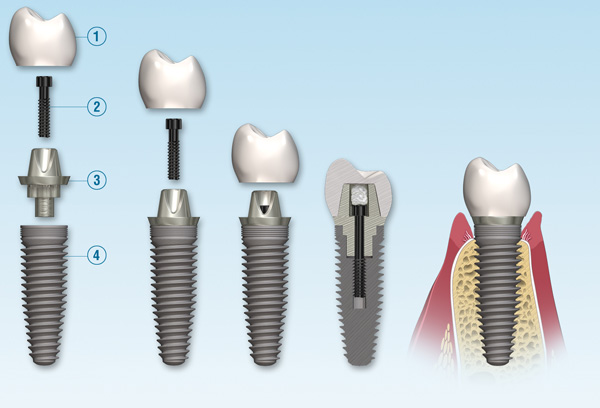
Single Tooth replacement :
Implant-supported porcelain crown: when a single tooth is lost, an implant is the ideal replacement for that tooth. A removable denture to replace a single tooth is not a highly desirable option for most patients, and a bridge can be placed but at the expense of the two neighboring teeth. Both alternatives listed are certainly valid treatment options, but the implant provides our patients the best solution to these problems and many more.
Benefits:
- Immediately functioning teeth (once healing is completed)
- Excellent esthetic results comparable to a natural tooth
- Usually a life long and stable solution with proper maintenance
- Eating and speaking function like natural
- Prevents loss of the surrounding bone
- Preserves integrity of surrounding teeth
- Preserves facial appearance
- No removable appliances
- No sacrificing of neighboring teeth
- Restore your mouth to an almost natural state
- No cavities, an implant or its tooth cannot get a cavity
- Yes, you will still require care and have to brush and floss
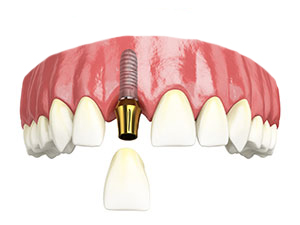
What's involved?
This procedure typically involves 4-5 visits with us at Old Hook Dental. Most patients are able to return to work the following day after having the implant placed. The first appointment will always be a complete examination with X-rays and models to determine if you are a candidate for implant placement.
- The implant is surgically placed and buried under your gums to allow the required 4-6 months to heal. In a few select cases, a temporary tooth can be provided that allows you to eat and function immediately; otherwise, alternative temporary options will be presented.
- Once healing has occurred and the implant has fused to bone, it is uncovered and either an abutment with a temporary crown or a healing cap will be placed; this will help contour the tissue into a nice anatomical form.
- Once achieved, the healing cap is removed for an impression to be taken and sent to the lab; the healing cap is replaced. When the final crown is returned, the abutment will be inserted with the final crown placed on top.
The treatment described here is only one example of several options available. Consult with us at Old Hook Dental to find out what the best solution is for you and your dental needs.
Alternatives to an implant-supported crown
Fixed bridge
A traditional bridge involves preparing adjacent teeth to support the replacement tooth between them. A bridge is fabricated as one single piece, replacing one or more missing teeth. Bridges have been used successfully in dentistry for decades: they are a time tested, solid solution with excellent esthetics and function. However, there are two main disadvantages when compared to implants: bone will continue to resorb in the area missing a tooth, and healthy teeth may need to be sacrificed on behalf of the bridge.
Click here for more information on fixed bridges.
Removable partial denture
This is a removable appliance to replace a lost tooth. It is supported by tissue and surrounding teeth by clasps. This is usually an undesirable option to replace one tooth as it offers less comfort and esthetics than an implant-supported prosthesis. It is, however, the most affordable option for multiple tooth replacement. They are constructed of metal and dental resin or can be made from all resin for improved esthetics.
Click here for more information on removable partial dentures.
Bonded bridge (Maryland)
A bonded bridge (or Maryland bridge) is a single porcelain tooth that has wings (or tabs) on the side that are bonded to neighboring teeth. It does offer some advantages: namely, it has high esthetics, is affordable and requires minimal preparation of adjacent teeth. These advantages come at the cost of strength, due to the minimal preparation and attachment Maryland bridges have a high tendency to come off or break, requiring it to be re-bonded or re-made. They are reserved for front teeth only as it is subjected to less force.
Click here for more information on Maryland bridges.
Multiple Teeth replacement :
Implant-supported porcelain crowns or bridge: When multiple teeth are lost, implants can be used to provide a strong, fixed solution that may not otherwise be possible. Illustrated by the picture on the left below, this patient would not be a candidate to have a traditional bridge placed as there are only teeth remaining on one side, where the patient on the right could have one. Alternatively, a removable denture is certainly a possible solution for both patients also. If the left patient wanted something fixed and permanent, then there are only two options: individual implants to replace each missing tooth, or an implant-supported bridge, which contains all of the teeth to be replaced in a single unit. The procedure for multiple implants is the same as described above, repeated for each tooth replaced. For an implant-supported bridge, two or more implants are placed and act as anchors to support the entire fixed bridge. As with single implant placement, the benefits and procedure are similar.
Benefits:
- Implants are the only fixed option in many situations
- Improved stability and strength over removable options
- Immediately functioning teeth (once healing is completed)
- Excellent esthetic results comparable to a natural teeth
- Usually a life long and stable solution with proper maintenance
- Eating and speaking function like natural
- Prevents loss of the surrounding bone
- Preserves integrity of surrounding teeth
- Preserves facial appearance
- No sacrificing of neighboring teeth
- Restores your mouth to an almost natural state
- No cavities, an implant or its tooth cannot get a cavity
- Yes, you still require care and have to brush and floss
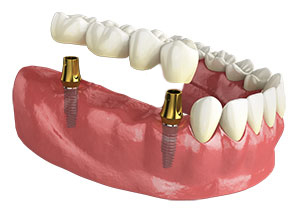
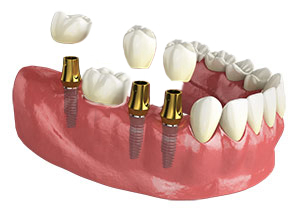
What's involved?
This procedure typically involves 4-5 visits with us at Old Hook Dental. Most patients are able to return to work the following day after having the implants placed. The first appointment will always be a complete examination with X-rays and models to determine if you are a candidate for implant placement.
- The implants are surgically placed simultaneously and buried under your gums to allow the required 4-6 months to heal. Unlike some single tooth implant cases, providing a temporary bridge or multiple crowns on the implants immediately is not possible.
- The forces it will be subjected to will overload them before they have healed causing them to fail, alternative temporary options will be presented.
- Once healing has occurred and the implants have fused to bone, they are uncovered and healing caps will be placed to help contour the tissue into a nice anatomical form.
- After the tissue has healed with a nice contour, the healing caps are removed for an impression to be taken and then replaced. When the final bridge or crowns return from the lab, the abutments will be inserted with the final prosthesis fixed on top.
The treatment described here is only one example of several options available. Consult with us at Old Hook Dental to find out what the best solution is for you and your dental needs.
Alternatives to implant supported crowns or bridge
Removable partial denture
This is a removable appliance to replace a lost tooth. It is supported by tissue and surrounding teeth by clasps. This is usually an undesirable option to replace one tooth as it offers less comfort and esthetics than an implant supported prosthesis. It is however the most affordable option for multiple tooth replacement. They are constructed of metal and dental resin or can be made from all resin for improved esthetics.
Click here for more information on removable partial dentures.
Full Arch Replacement :
Traditional dentures have been used successfully for hundreds of years and up until recently they were the ideal option for replacing all of your teeth. Why is that? Simple - they were the only option. Dental implants were only first invented in the 1960's and have not gained in popularity until a decade or two ago. With the increased availability, advances in technology and the wide spread use of dental implants, it is now possible for completely edentulous patients to have a full compliment of teeth. This enables them to eat their favorite foods, speak, smile and function like they used to, without any of the negatives associated with a complete denture. Not that there is anything wrong with a traditional denture; as mentioned, they work, have been used for hundreds of years and are still used today with great success. There are, however, newer alternatives we can provide that greatly improve the quality of life for our patients.
Implant-supported fixed full bridge:
When all of the teeth are lost (completely edentulous), an implant-supported fixed bridge by far offers our patients the best permanent solution for replacing their teeth. Unlike the two options listed next, this is a fixed prosthesis that is not removed (except by a dentist). They are made from porcelain and metal just like other bridges and screwed or cemented into place. A full arch of teeth can be supported using as little as 4 implants (it is referred to as an "All on four"); however, having 6 placed is highly recommend.
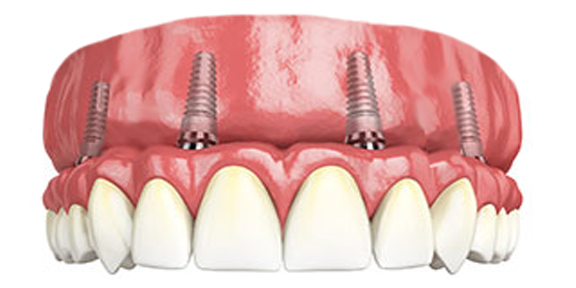
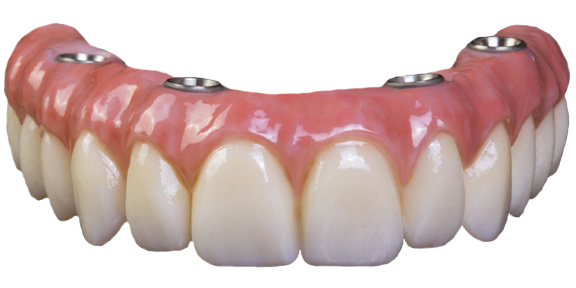
Implant-bar-supported overdenture:
An implant-bar-supported overdenture is a removable appliance, similar to a traditional denture with modifications made for added support and stability by using implants attached to a titanium metal bar. The denture is made with either porcelain teeth to improve the esthetics or acrylic teeth and has female attachments that snap over the bar providing good, solid retention. This type of prosthesis will usually require 2-4 implants to be placed. The overdenture options are usually sought out to either decrease costs or by prior denture wearers who want the increased stability that their traditional denture does not afford.
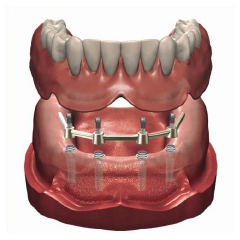
Implant-supported overdenture:
An implant-supported overdenture is a removable appliance, also similar to a traditional denture that provides increased support. Two or more implants are placed with male attachment points, the inside of the denture contains the female attachments and the denture snaps into place (similar to a button on a shirt). This increases retention and prevents the denture from moving and shifting when eating and speaking. This option is best used by denture wearers who do not have great bone and tissue support needed to retain the denture. Additionally, if you already have a traditional denture, it can be modified to add in the attachment points - this converts it from a traditional denture to an implant overdenture and significantly reduces the cost.
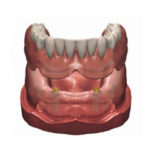
Benefits:
- Tremendous improvement in stability and strength over traditional dentures
- Improved quality of life
- Better speaking ability
- Increased chewing and eating ability
- Increased comfort
- Eliminates need for denture adhesives
- Excellent esthetic results are possible
- Usually a life long and stable solution with proper maintenance
- Prevents loss of the surrounding jaw bone
- Preserves integrity of facial height
- Preserves facial appearance
- Decreased wear of soft tissues
- Restores your mouth to a better functioning state
What's involved?
The procedure, time and number of visits varies. It is largely dependent on the starting condition and the final prosthesis you would like to have. You can expect around 8-10 visits to have a fixed bridge installed. Despite requiring multiple implants, most patients report that they are quite comfortable following the procedure and able to return to work. As always, the first appointment consists of a comprehensive exam, panoramic X-ray and models to determine if you are a candidate for implants.
- The implants are surgically placed simultaneously and buried under your gums to allow the required 4-6 months to heal.
- There are cases and scenarios where immediate loading of the implants is possible, but for the majority of cases it will require healing first and alternative temporary options will be presented.
- After healing and the implants have integrated into the bone, healing caps will be placed to contour the tissue, they will be worn for roughly 2 weeks.
- After which the healing caps are removed and a verification jig is made and an impression is taken. The information is sent to the lab so the construction of the framework and teeth can begin.
- Depending on which treatment choice you desire, either the framework for the bridge or denture and bar will be tried in to ensure a good fit. Once satisfied, it is returned to the lab for final processing.
- The final prosthesis is tried in again, evaluated and if everything fits properly it is secured in place.
Alternatives to an implant supported prosthesis
Complete denture (traditional)
This is a removable appliance to replace an entire arch of lost teeth. It is supported by tissue and underlying bone. This option offers less comfort and esthetics than an implant supported prosthesis, however it is the most affordable option for multiple tooth replacement. They are constructed of dental resin and teeth can either be made from the same or in porcelain for improved esthetics.
Click here for more information on complete dentures.
Schedule an appointment
If you have experienced tooth loss, it is not only an esthetic concern, it is also important to address the problem to protect your smile and the integrity of the rest of your teeth to keep it functioning for years. Learn more about the options offered at Old Hook Dental and the treatment benefits of having an implant supported prosthesis.
Call to schedule your appointment with us at Old Hook Dental (201) 358-5005 or Click here to contact us